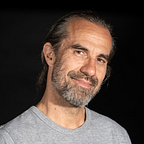A kind of Tony: story of a documentary interview with legend jazzman Tony Scott
In the summer of 2001, just before 9/11, just before my eventful tenure at the New York Film Academy, I met one of the few living jazz legends who had played with Charlie Parker and Billie Holiday. An endearing bearded man, quite a mythomaniac -who was one of the first to perform behind the Soviet Iron Curtain- who fused African and Oriental music before anyone else, and transcended his bebop origins to invent the new age sound. That encounter, filmed with a camcorder that I was driving in fits and starts, has been kept in my archives until today, more than 20 years later when it finally comes to light in the form of a short documentary film.
Anthony Sciacca, probably Antonio for his family of Sicilian origins, was an extraordinary clarinetist who burst onto the lively American jazz scene in the 1950s, under the stage name of Tony Scott. Gifted for rubbing shoulders with swing stars, such as Benny Goodman or Woody Herman, he was immediately fascinated by the rupture proposed by Charlie Parker and the beboppers. He began to stand out in his thirties, but fate had prepared another life for him (read the obituary of good Chema García published in EL PAÍS for his death).
When I met Tony I was working as editor-in-chief at the magnificent Cuadernos de Jazz (surrounded by the only ones who knew what they were saying and writing about jazz in this country). One of my functions was to extend international links and collaborations between media (a well-researched chimera in the unbridled egocentric universe of jazz journalism), and along those paths of the pre-Internet era I met Luciano Vanni and his enthusiastic publishing project JAZZIT (a magazine that placed the creation and dissemination of jazz made in Italy at the center of information). Being two pazzi dreamers we hit it off from minute 1, and in one of our fantasies we planned to make a documentary on Tony Scott, the rebellious jazz clarinet player who had lived in an apartment in Rome for years.
“First came jazz, then came sex” Tony Scott
The meeting with Tony was one of those bizarre visits that life as a journalist -sometimes- throws at you, and I have always been a fan of portraits at home. Jumping between Italian and English, music blaring in his living room, dressed in a colorful Pollock-style brushstroke suit, while my colleague Luciano was trying to track down his ragazza (love’s a hard business for italians), I was able to sit down and record a conversation with Tony (which served as the basis for an interview that was never published in Cuadernos, and as a teaser to move financing for the possible film project in documentary markets). Note: despite the interest shown by various entities, and one of the most connected producers in Italy, the film did not happen. Some time later, three years after Tony’s death in 2007, a film called Io sono Tony Scott (directed by Franco Maresco) was released. So I abandoned the idea of doing something with that material.
Note: despite the interest shown by various entities, and one of the most connected producers in Italy, the docu did not come out. Some time later, three years after Tony’s death in 2007, Io sono Tony Scott (directed by Franco Maresco) was released. So I abandoned the idea of doing something with that material.
However, every time I’d review it, I was hooked by the beautiful chaos of that conversation and what it displayed in just under forty minutes of raw footage. I seriously considered producing a medium-length film with that material, but one of the frustrating firewalls in music documentaries (music rights) became heavy and unreasonable (without giving names, the heirs of musical legacies are not the best friends of cinema).
So after several edits, I dared to do what the material asked for. A non-musical portrait of this enormous musician. Precisely what musicians have always hated: words. But it just happens that Tony was precisely a better improviser in his stories than possibly in his broken clarinet solos…
The result is 17 minutes of conversation, a guided tour commented by Tony Scott himself around the photos in his living room (he was a great amateur photographer who managed to exhibit his collection at the Fnac in Paris), reflections on life and art, and some invented stories, or maybe just distorted by his fanciful memory…
Mainly, I wanted to show a tribute to this truly extraordinary guy, who shook musical structures by accident (his album Music for Zen Meditation is arguably the first best seller of New Age), inspired many to merge supposedly antagonistic sounds -like jazz and Asian folk-, and above all marked a generation of Italian musicians with his presence, his concerts, and his delusions.
So stay teuned: this film will (should) be able to be seen (soon) on the big screen.
